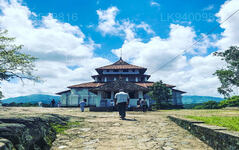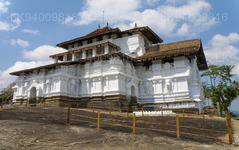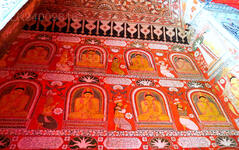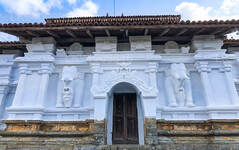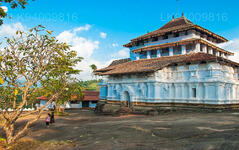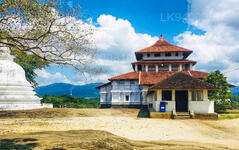
Město Kandy
Kandy, malebné město ve střední části Srí Lanky, je proslulé svým bohatým kulturním dědictvím, pulzujícími festivaly a malebnou krásou. Uprostřed bujných kopců se nachází Chrám Buddhova zubu, který je zapsán na seznamu světového dědictví UNESCO, a nabízí podmanivou směs historie a přírodní krásy.
Lankathilaka Viharaya
Lankathilaka Viharaya in Sri Lanka: The Great Temple of the Kings
Lankatilaka is Buddhist temple of the 14th century in the Hiyarapitiya village, from the Udu Nuwara area of Kandy district in Sri Lanka. This historical temple was built by the Gampola king, King Buwanekabahu the fourth (1341 – 1351AD), in 1344 AD. Gampola was a stronghold on the banks of Mahaveli River.
Lankathilaka Viharaya in Sri Lanka: Architectural Facts
- The temple was designed by the South Indian architect Sthapati Rayar.
- According to the opinions of researchers; the temple combines the design elements of the Polonnaruwa era architecture with that of Dravidian (India) and Indo-Chinese design. At the time of construction the temple was a four storied edifice of eighty feet, built on uneven bedrock using a granite based foundation.
- The temple structure is such that it radiates from the centre in the four cardinal directions, like a cross. Only then ground floor and part of the first floor of the original temple can be seen today, though the temple appears to have three stories from the outside.
- The thick outer walls of the Temple have beautifully sculpted arches and various sculptures making it a unique design of the 14th century.
Lankathilaka Viharaya in Sri Lanka: Sights when entering the Temple
- There are two directions of approach to the temple. One of them has abodes for Buddhist monks at the base of the rock.
- The premises also have many sights such as the huge rice storage bins, known as ‘Atuwa’ by the locals. The stairs begin in the premises of the abodes.
- The other method of approach is from the west of the temple.
- With two ways of approach come two different flights of stairs. One is the original flight built in the 14th century, while the other is more recent; built around 1913. The stairs are cut into the living rock of Pahangalla and provide a climber with beautiful views of the surrounding countryside.
- At the top of the old flight of stairs, the premises of the temple can be entered through a primitive stone door arch, created with three long pieces of rock affixed together.
Lankathilaka Viharaya in Sri Lanka: The Temple
The temple premises have three sectors; the actual temple building, the Dagoba or stupa and finally the Bo tree.
The temple like the flights of stairs has two entrances, leading to two different and disconnected sections in the same building. The main and most important sector is the eastern section, the Buddha Image House. The other is on the west, the the Temples of the Gods.
The Buddha Image House
- The Buddha Image House which is approached from the eastern entrance, right in front of the eastern flight of stairs, and has a Moonstone adorning the ground before the entrance.
- Def. Moonstone: A semi-circular piece of stone which stands at the foot of a flight of steps in most historical Buddhist buildings.
- Two balustrades carved with the Gajasinha or elephant headed lion hybrid design flank the short flight of stairs leading to the entrance archway of the temple.
- The outer archway has a Makara Torana or dragon figure with some unique characteristics that differentiate it from the usual Makara Toranas.
- On the wide inside side walls of the archway display wonderfully preserved paintings of lions. A pair of guardian statues stands close to the wooden door, which has several panels painted with creepers and various designs.
- The inside of the Buddha Image House is an art masterpiece in its entirety with the walls and ceiling completely covered in beautiful paintings dating back to the construction of the temple.
- The pigments used are mostly red, white, yellow and black; with red being the dominant colour possibly because ochre was a pigment that could last the ravages of time.
- The paintings depict the lives of the 24 former Buddhas on the walls, while the ceiling has an abstract flower design.
- The centrepiece of the Buddha Image House is a beautiful golden toned seated Buddha statue. Above the statue is another Makara Torana with sculptures of angels watching over.
Lankathilaka Viharaya in Sri Lanka: Rock Inscriptions
There are inscriptions cut into the rock surface on the temple premises. The inscriptions are both in Sinhala and Tamil, stating that the land was gifted to the Temple by the kings and describing other facilities offered to the temple.
The Lankatilaka Temple is a beautiful cultural heritage of Sri Lanka that has to be visited on a holiday to the country. This temple along with the Embekke temple remains one of the most architecturally advanced structures of the Gampola Kingdom era.
O okrese Kandy
Okres Kandy se nachází v centrální provincii Srí Lanky. Kandy, jedno ze sedmi míst světového dědictví UNESCO na Srí Lance, bylo kdysi v 16. století domovem kandyjských králů a pramenem veškeré hudby, umění, řemesel a kultury v zemi. Kandy se nachází asi 129 km od Kolomba v kopcovitém terénu a všechny zraky jsou upřeny do centra města, kde okouzlujícím dominantou je jezero Kandy. Kandy si pro Srí Lanku zachovává velký náboženský význam, protože právě v tomto okouzlujícím městě se nachází Dalada Maligawa neboli „Chrám Buddhova zubu“, v němž je dobře střežena posvátná relikvie zubu Buddhy.
Královská botanická zahrada v Peradeniyi se nachází asi 5 km západně od centra města Peradeniya a ročně ji navštíví 1,2 milionu lidí. Je to největší botanická zahrada na ostrově. Udawatta Kele (les Udawatta) je chráněná přírodní rezervace nacházející se v srdci města, severně od Chrámu zubu.
Kandy je město s většinou sinhálského obyvatelstva; žijí zde početné komunity patřící k jiným etnickým skupinám, jako jsou Maurové a Tamilové. Kandy je hned po Kolombu druhým centrem srílanské ekonomiky. Mnoho velkých družstev má v Kandy velké pobočky a nachází se zde mnoho průmyslových odvětví, včetně textilního, nábytkářského, informačních technologií a šperků. Ve městě se nachází mnoho center zemědělského výzkumu.
A pramen veškeré hudby, umění, řemesel a kultury v zemi. Kandy se nachází asi 129 km od Kolomba v kopcovitém terénu a všechny zraky jsou upřeny do centra města, kde okouzlujícím dominantou je jezero Kandy. Kandy si pro Srí Lanku zachovává velký náboženský význam, protože právě v tomto okouzlujícím městě se nachází Dalada Maligawa neboli Chrám Buddhova zubu, v němž je dobře střežena posvátná relikvie Buddhova zubu.
O Centrální provincii
Centrální provincie Srí Lanky se skládá převážně z hornatého terénu. Provincie má rozlohu 5 674 km² a 2 421 148 obyvatel. Mezi větší města patří Kandy, Gampola (24 730), Nuwara Eliya a Bandarawela. Obyvatelstvo je směsicí Sinhálců, Tamilů a Maurů.
Jak horské hlavní město Kandy, tak i město Nuwara Eliya se nacházejí v Centrální provincii, stejně jako Srí Pada. Provincie produkuje velkou část slavného cejlonského čaje, který Britové vysadili v 60. letech 19. století poté, co ničivá nemoc zničila všechny kávové plantáže v provincii. Centrální provincie přitahuje mnoho turistů, a to díky městům v horských oblastech, jako jsou Kandy, Gampola, Hatton a Nuwara Eliya. Chrám Buddhova zubu neboli Dalada Maligawa je hlavním posvátným místem v Centrální provincii.
Podnebí je chladné a mnoho oblastí v nadmořské výšce okolo 1500 metrů má často chladné noci. Západní svahy jsou velmi vlhké, na některých místech spadne téměř 7000 mm srážek ročně. Východní svahy patří do středně suché zóny, protože zde spadne pouze severovýchodní monzun. Teploty se pohybují od 24 °C v Kandy do pouhých 16 °C v Nuwara Eliya, která se nachází 1 889 m nad mořem. Nejvyšší hory Srí Lanky se nacházejí v Centrální provincii. Terén je převážně hornatý s hlubokými údolími, která se do něj zařezávají. Dvěma hlavními horskými oblastmi jsou centrální masiv a pohoří Knuckles východně od Kandy.

